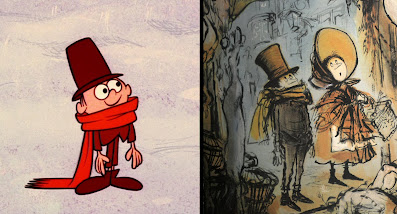The British Invasion as a pop cultural reference usually refers to the wave of British bands that began to infiltrate American pop music starting in 1962. However, there was a sort of pre-British Invasion when it came to the culture in general. The vanguard was led by several British-themed musicals and plays in 1960-Robert Bolt’s A Man For All Seasons, Lerner and Lowe’s Camelot and most importantly for Mr. Magoo, Oliver!, with music, lyrics and book by Lionel Bart and based on Charles Dickens’ Oliver Twist.
Shortly after the debut of the Dickens musical, an edition of A Christmas Carol with illustrations by Ronald Searle, the renowned British cartoonist, was published. (World Publishing Co., copyright 1960, 1961.) Searle illustrated two more of Dickens’ works, Great Expectations and Oliver Twist, both published in 1962. The Magoo special had its debut on the NBC network in December 1962.
It appears that Dickens was experiencing a bit of a cultural renaissance and both Bart’s musical and Searle’s book had a hand in the genesis of Mr. Magoo's Christmas Carol. The success of Oliver! clearly influenced the decision to make an animated musical based on A Christmas Carol and Searle's book seems to have inspired the artists at UPA as they designed the special-a UPA stamped copy of the book was found in Abe Levitow’s personal collection of material from the film.
 |
| This early pre-production art shows the strongest Searle influence, artist unknown |
 | |||
| A greatly simplified version of the fiddler by designer Lee Mishkin |
 |
| Tony Rivera's design for the turkey boy as animated by Duane Crowther |
These few designs by Lee Mishkin and Tony Rivera unfortunately pale in comparison to Searle's florid line work but the two were working in a different discipline and constricted by production methodology and budget. Viewed by themselves, the designs are extremely appealing and contribute enormously to the charm of the film.
Mishkin was not alone in referencing Searle; many of his contemporaries were also influenced by Ronald Searle's work. In fact, Searle caught Disney designer Tom Oreb poaching what he felt was his horse design for Samson in Sleeping Beauty, and the host and contestants on "What's My Crime?" in 101 Dalmatians, also designed by Oreb, have a distinctly Searle feel to them. Even the line work in the backgrounds for 101 Dalmatians,created by layout man Ernie Nordli, echoes Searle's own backgrounds.
To see more from Ronald Searle's lavishly illustrated edition of A Christmas Carol, as well as his other Dickens' editions, click here.









